University Business Law Assignment: Employment Contract Analysis
VerifiedAdded on 2020/03/28
|9
|1966
|103
Report
AI Summary
This business law assignment examines two key issues in employment law: distinguishing between an employee and an independent contractor, and the application of redundancy rules. The first issue involves analyzing a scenario where an actor, Amanda, is contracted by Monk Pty Ltd. The analysis utilizes the 'multiple indicia test' derived from cases like Stevens v Broadribb Sawmilling Co Pty and Hollis v Vabu Pty Ltd to determine Amanda's employment status, considering factors such as control, payment, risk, and exclusivity. The assignment concludes that Amanda is likely an independent contractor. The second issue explores whether Ken can claim that the 'last on, first off' rule was part of his employment contract, in a redundancy scenario. The analysis considers common law obligations, employment contract terms, and industry practices, referencing the Australian Iron & Steel Pty Ltd v Banovic case. The report concludes that the 'last on, first off' rule was not part of the contract, but qualification based redundancy was.

Running head: BUSINESS LAW
Business law
Name of the Student
Name of the University
Author Note
Business law
Name of the Student
Name of the University
Author Note
Paraphrase This Document
Need a fresh take? Get an instant paraphrase of this document with our AI Paraphraser
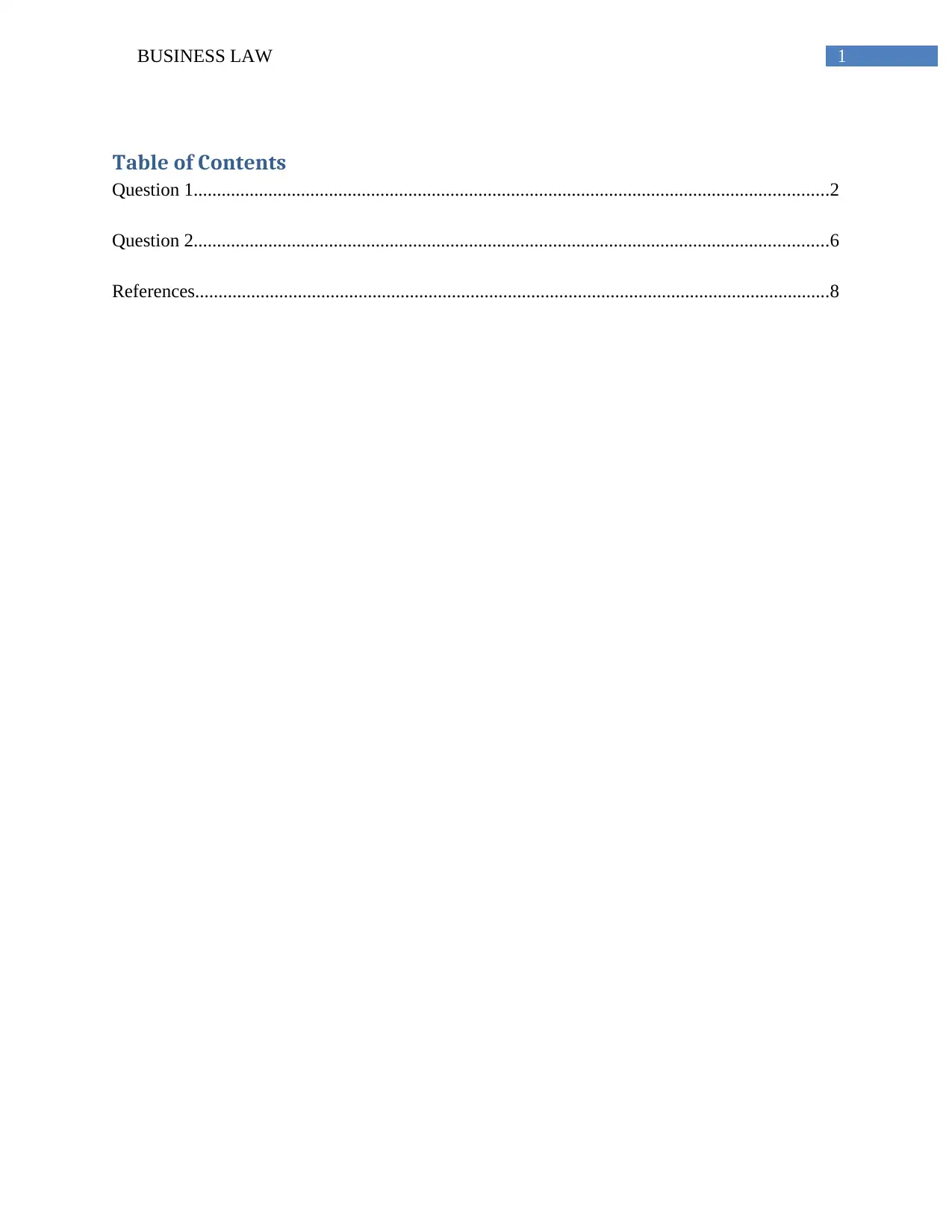
1BUSINESS LAW
Table of Contents
Question 1........................................................................................................................................2
Question 2........................................................................................................................................6
References........................................................................................................................................8
Table of Contents
Question 1........................................................................................................................................2
Question 2........................................................................................................................................6
References........................................................................................................................................8
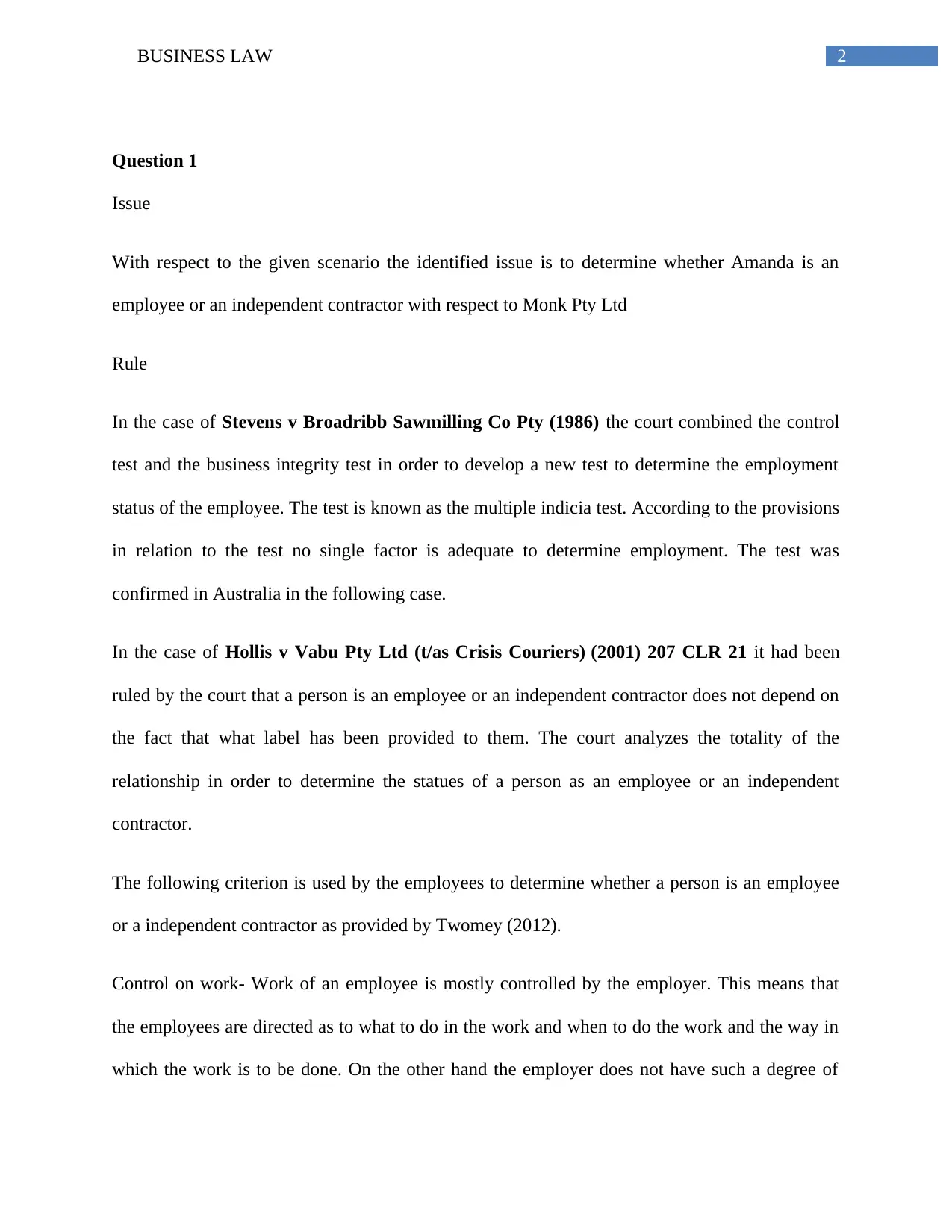
2BUSINESS LAW
Question 1
Issue
With respect to the given scenario the identified issue is to determine whether Amanda is an
employee or an independent contractor with respect to Monk Pty Ltd
Rule
In the case of Stevens v Broadribb Sawmilling Co Pty (1986) the court combined the control
test and the business integrity test in order to develop a new test to determine the employment
status of the employee. The test is known as the multiple indicia test. According to the provisions
in relation to the test no single factor is adequate to determine employment. The test was
confirmed in Australia in the following case.
In the case of Hollis v Vabu Pty Ltd (t/as Crisis Couriers) (2001) 207 CLR 21 it had been
ruled by the court that a person is an employee or an independent contractor does not depend on
the fact that what label has been provided to them. The court analyzes the totality of the
relationship in order to determine the statues of a person as an employee or an independent
contractor.
The following criterion is used by the employees to determine whether a person is an employee
or a independent contractor as provided by Twomey (2012).
Control on work- Work of an employee is mostly controlled by the employer. This means that
the employees are directed as to what to do in the work and when to do the work and the way in
which the work is to be done. On the other hand the employer does not have such a degree of
Question 1
Issue
With respect to the given scenario the identified issue is to determine whether Amanda is an
employee or an independent contractor with respect to Monk Pty Ltd
Rule
In the case of Stevens v Broadribb Sawmilling Co Pty (1986) the court combined the control
test and the business integrity test in order to develop a new test to determine the employment
status of the employee. The test is known as the multiple indicia test. According to the provisions
in relation to the test no single factor is adequate to determine employment. The test was
confirmed in Australia in the following case.
In the case of Hollis v Vabu Pty Ltd (t/as Crisis Couriers) (2001) 207 CLR 21 it had been
ruled by the court that a person is an employee or an independent contractor does not depend on
the fact that what label has been provided to them. The court analyzes the totality of the
relationship in order to determine the statues of a person as an employee or an independent
contractor.
The following criterion is used by the employees to determine whether a person is an employee
or a independent contractor as provided by Twomey (2012).
Control on work- Work of an employee is mostly controlled by the employer. This means that
the employees are directed as to what to do in the work and when to do the work and the way in
which the work is to be done. On the other hand the employer does not have such a degree of
⊘ This is a preview!⊘
Do you want full access?
Subscribe today to unlock all pages.

Trusted by 1+ million students worldwide
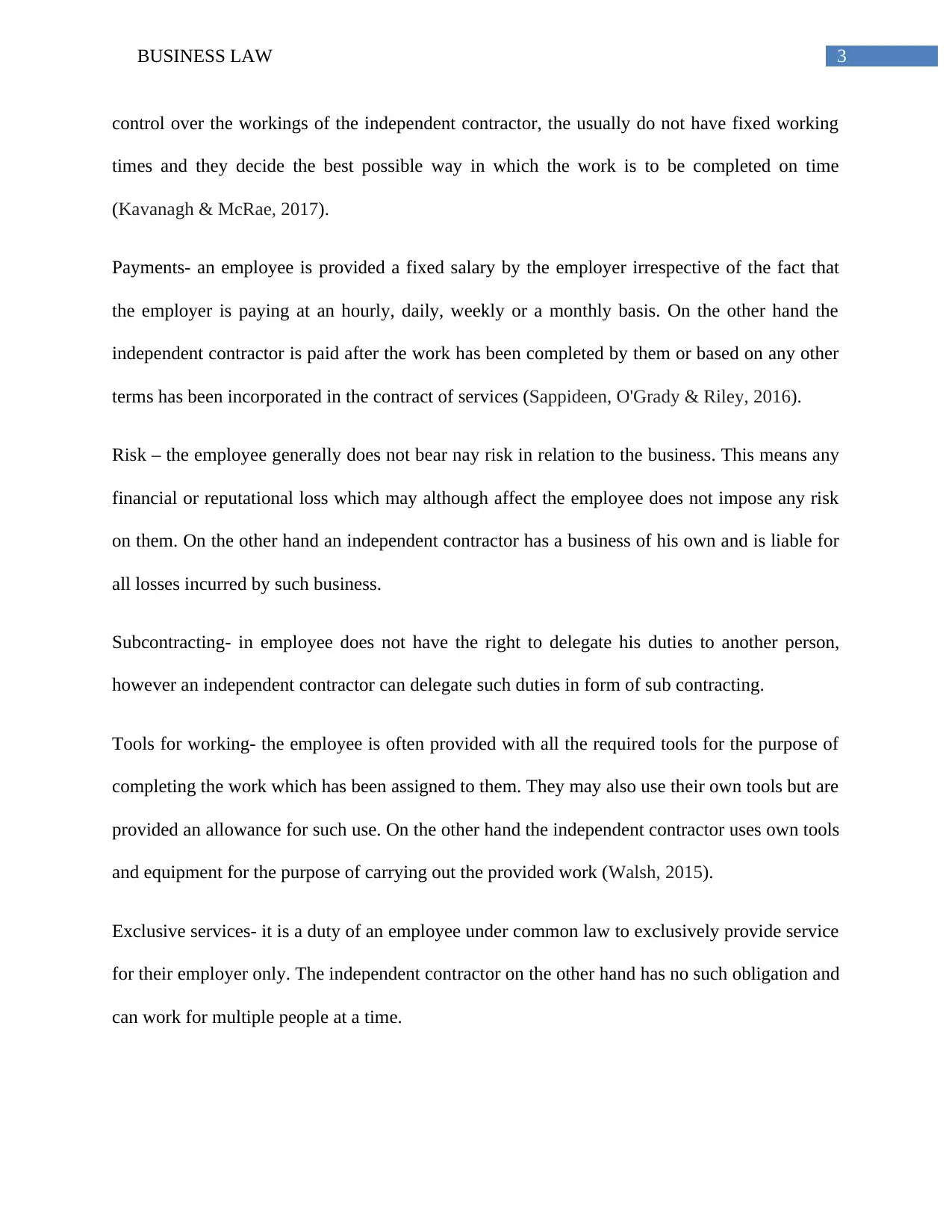
3BUSINESS LAW
control over the workings of the independent contractor, the usually do not have fixed working
times and they decide the best possible way in which the work is to be completed on time
(Kavanagh & McRae, 2017).
Payments- an employee is provided a fixed salary by the employer irrespective of the fact that
the employer is paying at an hourly, daily, weekly or a monthly basis. On the other hand the
independent contractor is paid after the work has been completed by them or based on any other
terms has been incorporated in the contract of services (Sappideen, O'Grady & Riley, 2016).
Risk – the employee generally does not bear nay risk in relation to the business. This means any
financial or reputational loss which may although affect the employee does not impose any risk
on them. On the other hand an independent contractor has a business of his own and is liable for
all losses incurred by such business.
Subcontracting- in employee does not have the right to delegate his duties to another person,
however an independent contractor can delegate such duties in form of sub contracting.
Tools for working- the employee is often provided with all the required tools for the purpose of
completing the work which has been assigned to them. They may also use their own tools but are
provided an allowance for such use. On the other hand the independent contractor uses own tools
and equipment for the purpose of carrying out the provided work (Walsh, 2015).
Exclusive services- it is a duty of an employee under common law to exclusively provide service
for their employer only. The independent contractor on the other hand has no such obligation and
can work for multiple people at a time.
control over the workings of the independent contractor, the usually do not have fixed working
times and they decide the best possible way in which the work is to be completed on time
(Kavanagh & McRae, 2017).
Payments- an employee is provided a fixed salary by the employer irrespective of the fact that
the employer is paying at an hourly, daily, weekly or a monthly basis. On the other hand the
independent contractor is paid after the work has been completed by them or based on any other
terms has been incorporated in the contract of services (Sappideen, O'Grady & Riley, 2016).
Risk – the employee generally does not bear nay risk in relation to the business. This means any
financial or reputational loss which may although affect the employee does not impose any risk
on them. On the other hand an independent contractor has a business of his own and is liable for
all losses incurred by such business.
Subcontracting- in employee does not have the right to delegate his duties to another person,
however an independent contractor can delegate such duties in form of sub contracting.
Tools for working- the employee is often provided with all the required tools for the purpose of
completing the work which has been assigned to them. They may also use their own tools but are
provided an allowance for such use. On the other hand the independent contractor uses own tools
and equipment for the purpose of carrying out the provided work (Walsh, 2015).
Exclusive services- it is a duty of an employee under common law to exclusively provide service
for their employer only. The independent contractor on the other hand has no such obligation and
can work for multiple people at a time.
Paraphrase This Document
Need a fresh take? Get an instant paraphrase of this document with our AI Paraphraser

4BUSINESS LAW
Uniforms- the employees are provided uniform by the employers to be worn during the course of
employment which contains the name or logo of the employer. On the other hand no such
uniform us required to be worn by an independent employer. However merely because a person
is not wearing uniform does not make such person an independent contractor.
Income tax- The tax of an employee is already deducted by the employer and paid by the
employer to the Australian Taxation Office. On the other hand the contractors have to obtain a
personal ATO number and pay their own tax (Kaplan & Botes, 2015).
Superannuation- the employer has to make a superannuation contribution to the employees
which are currently at 9.5% of their salary. On the other hand the independent contractors have
to make contribution by their own.
Leave- an employee is entailed to various leaves by as prescribed by law in form of paid leaves
such as annual leave and sick leave. On the other hand the independent contractor is not allowed
to take any leave and if they do they are not entitled to be paid for such leaves.
ACE Insurance Limited v Trifunovski [2013] FCAFC 3, it was held by the court that although
the defendant employed the plaintiff as an independent contractor the plaintiff was actually an
agent and the defendant company is liable to pay compensation and leave allowance.
Application
It has been provided by the scenario that Amanda has been chosen by Monks Pty Ltd to work as
an actor in a new serial. The terms of the contract which was signed between Amanda and
Monks pty Ltd provided that Amanda has to be available for work all the time as she requires to
fill a central role in the serial. In addition it has been stated that Amanda would be provided no
Uniforms- the employees are provided uniform by the employers to be worn during the course of
employment which contains the name or logo of the employer. On the other hand no such
uniform us required to be worn by an independent employer. However merely because a person
is not wearing uniform does not make such person an independent contractor.
Income tax- The tax of an employee is already deducted by the employer and paid by the
employer to the Australian Taxation Office. On the other hand the contractors have to obtain a
personal ATO number and pay their own tax (Kaplan & Botes, 2015).
Superannuation- the employer has to make a superannuation contribution to the employees
which are currently at 9.5% of their salary. On the other hand the independent contractors have
to make contribution by their own.
Leave- an employee is entailed to various leaves by as prescribed by law in form of paid leaves
such as annual leave and sick leave. On the other hand the independent contractor is not allowed
to take any leave and if they do they are not entitled to be paid for such leaves.
ACE Insurance Limited v Trifunovski [2013] FCAFC 3, it was held by the court that although
the defendant employed the plaintiff as an independent contractor the plaintiff was actually an
agent and the defendant company is liable to pay compensation and leave allowance.
Application
It has been provided by the scenario that Amanda has been chosen by Monks Pty Ltd to work as
an actor in a new serial. The terms of the contract which was signed between Amanda and
Monks pty Ltd provided that Amanda has to be available for work all the time as she requires to
fill a central role in the serial. In addition it has been stated that Amanda would be provided no
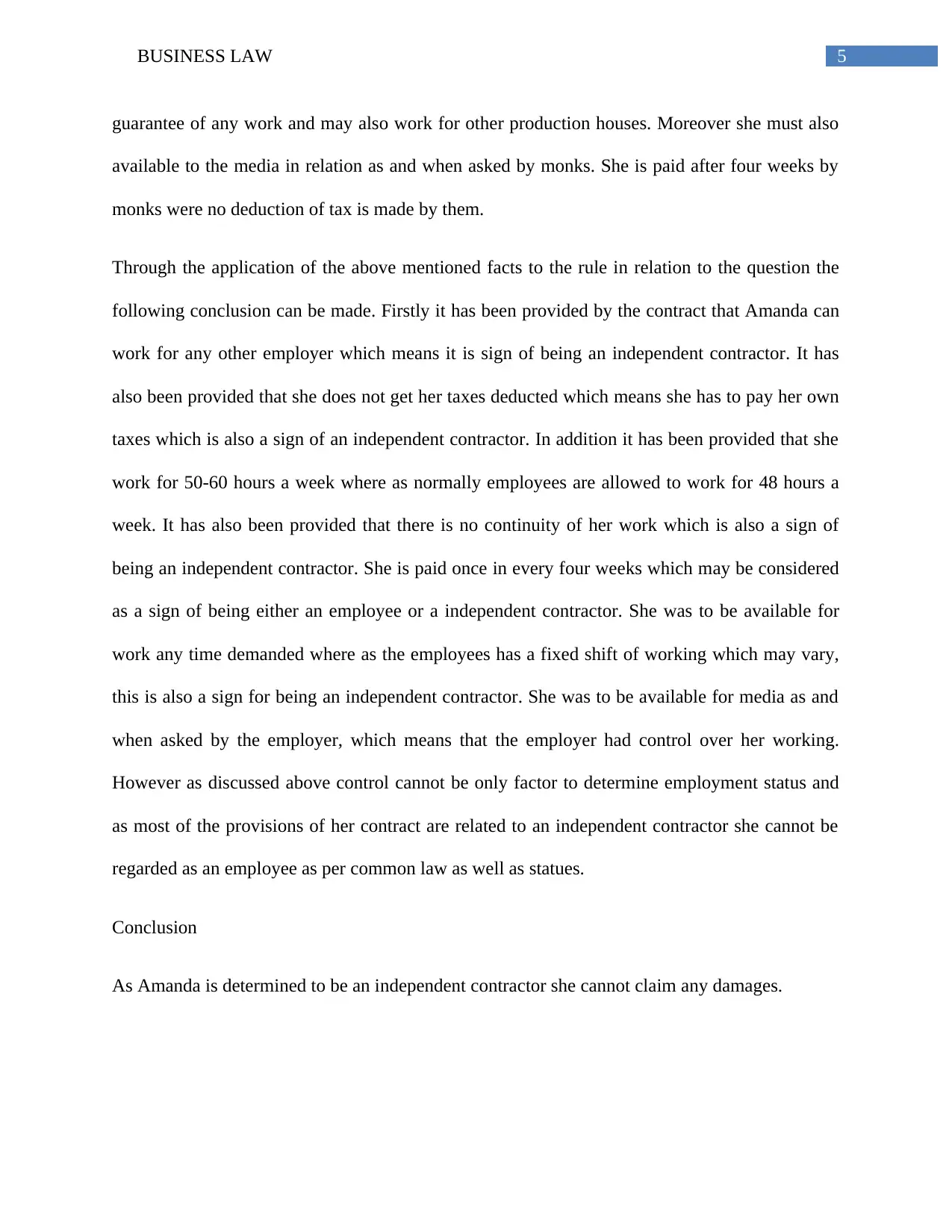
5BUSINESS LAW
guarantee of any work and may also work for other production houses. Moreover she must also
available to the media in relation as and when asked by monks. She is paid after four weeks by
monks were no deduction of tax is made by them.
Through the application of the above mentioned facts to the rule in relation to the question the
following conclusion can be made. Firstly it has been provided by the contract that Amanda can
work for any other employer which means it is sign of being an independent contractor. It has
also been provided that she does not get her taxes deducted which means she has to pay her own
taxes which is also a sign of an independent contractor. In addition it has been provided that she
work for 50-60 hours a week where as normally employees are allowed to work for 48 hours a
week. It has also been provided that there is no continuity of her work which is also a sign of
being an independent contractor. She is paid once in every four weeks which may be considered
as a sign of being either an employee or a independent contractor. She was to be available for
work any time demanded where as the employees has a fixed shift of working which may vary,
this is also a sign for being an independent contractor. She was to be available for media as and
when asked by the employer, which means that the employer had control over her working.
However as discussed above control cannot be only factor to determine employment status and
as most of the provisions of her contract are related to an independent contractor she cannot be
regarded as an employee as per common law as well as statues.
Conclusion
As Amanda is determined to be an independent contractor she cannot claim any damages.
guarantee of any work and may also work for other production houses. Moreover she must also
available to the media in relation as and when asked by monks. She is paid after four weeks by
monks were no deduction of tax is made by them.
Through the application of the above mentioned facts to the rule in relation to the question the
following conclusion can be made. Firstly it has been provided by the contract that Amanda can
work for any other employer which means it is sign of being an independent contractor. It has
also been provided that she does not get her taxes deducted which means she has to pay her own
taxes which is also a sign of an independent contractor. In addition it has been provided that she
work for 50-60 hours a week where as normally employees are allowed to work for 48 hours a
week. It has also been provided that there is no continuity of her work which is also a sign of
being an independent contractor. She is paid once in every four weeks which may be considered
as a sign of being either an employee or a independent contractor. She was to be available for
work any time demanded where as the employees has a fixed shift of working which may vary,
this is also a sign for being an independent contractor. She was to be available for media as and
when asked by the employer, which means that the employer had control over her working.
However as discussed above control cannot be only factor to determine employment status and
as most of the provisions of her contract are related to an independent contractor she cannot be
regarded as an employee as per common law as well as statues.
Conclusion
As Amanda is determined to be an independent contractor she cannot claim any damages.
⊘ This is a preview!⊘
Do you want full access?
Subscribe today to unlock all pages.

Trusted by 1+ million students worldwide
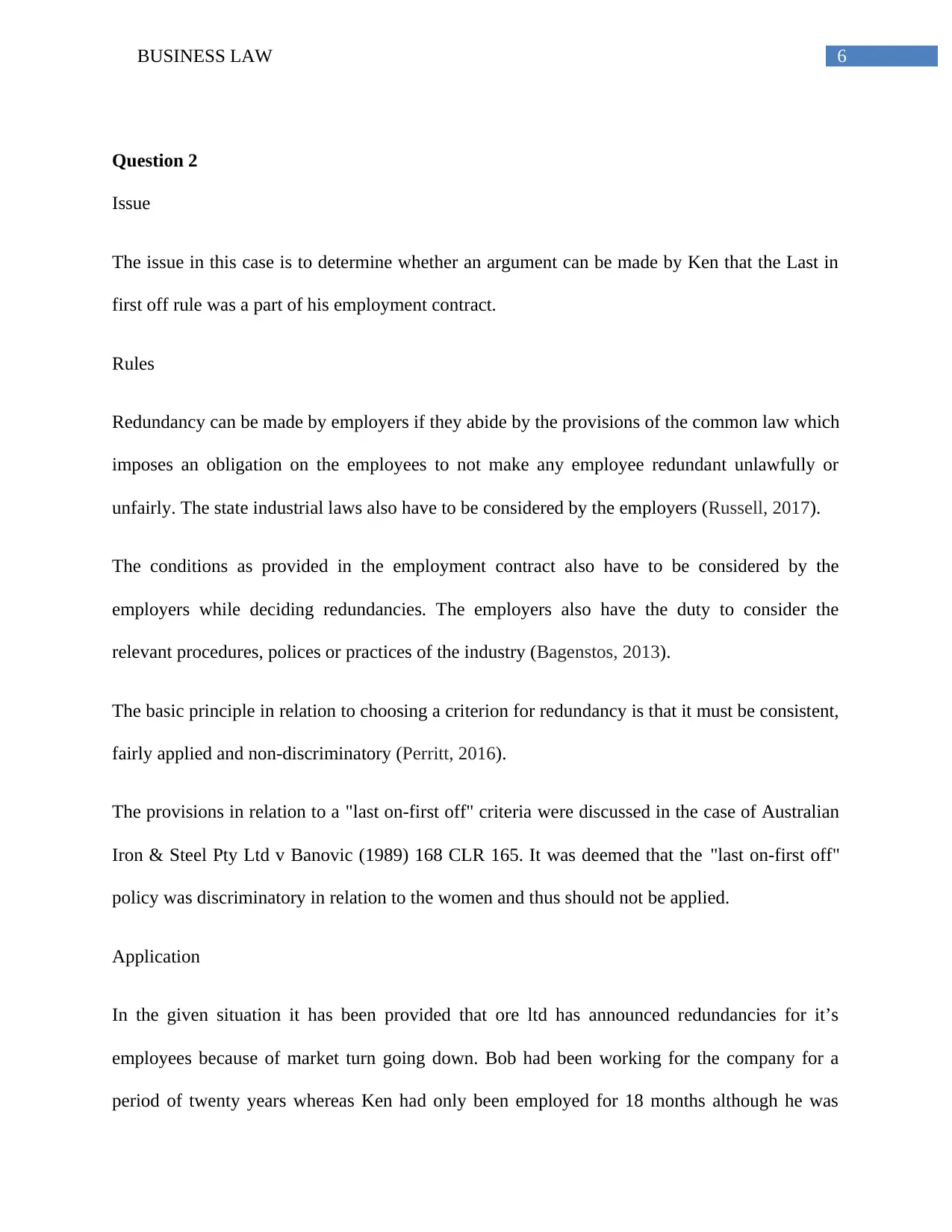
6BUSINESS LAW
Question 2
Issue
The issue in this case is to determine whether an argument can be made by Ken that the Last in
first off rule was a part of his employment contract.
Rules
Redundancy can be made by employers if they abide by the provisions of the common law which
imposes an obligation on the employees to not make any employee redundant unlawfully or
unfairly. The state industrial laws also have to be considered by the employers (Russell, 2017).
The conditions as provided in the employment contract also have to be considered by the
employers while deciding redundancies. The employers also have the duty to consider the
relevant procedures, polices or practices of the industry (Bagenstos, 2013).
The basic principle in relation to choosing a criterion for redundancy is that it must be consistent,
fairly applied and non-discriminatory (Perritt, 2016).
The provisions in relation to a "last on-first off" criteria were discussed in the case of Australian
Iron & Steel Pty Ltd v Banovic (1989) 168 CLR 165. It was deemed that the "last on-first off"
policy was discriminatory in relation to the women and thus should not be applied.
Application
In the given situation it has been provided that ore ltd has announced redundancies for it’s
employees because of market turn going down. Bob had been working for the company for a
period of twenty years whereas Ken had only been employed for 18 months although he was
Question 2
Issue
The issue in this case is to determine whether an argument can be made by Ken that the Last in
first off rule was a part of his employment contract.
Rules
Redundancy can be made by employers if they abide by the provisions of the common law which
imposes an obligation on the employees to not make any employee redundant unlawfully or
unfairly. The state industrial laws also have to be considered by the employers (Russell, 2017).
The conditions as provided in the employment contract also have to be considered by the
employers while deciding redundancies. The employers also have the duty to consider the
relevant procedures, polices or practices of the industry (Bagenstos, 2013).
The basic principle in relation to choosing a criterion for redundancy is that it must be consistent,
fairly applied and non-discriminatory (Perritt, 2016).
The provisions in relation to a "last on-first off" criteria were discussed in the case of Australian
Iron & Steel Pty Ltd v Banovic (1989) 168 CLR 165. It was deemed that the "last on-first off"
policy was discriminatory in relation to the women and thus should not be applied.
Application
In the given situation it has been provided that ore ltd has announced redundancies for it’s
employees because of market turn going down. Bob had been working for the company for a
period of twenty years whereas Ken had only been employed for 18 months although he was
Paraphrase This Document
Need a fresh take? Get an instant paraphrase of this document with our AI Paraphraser
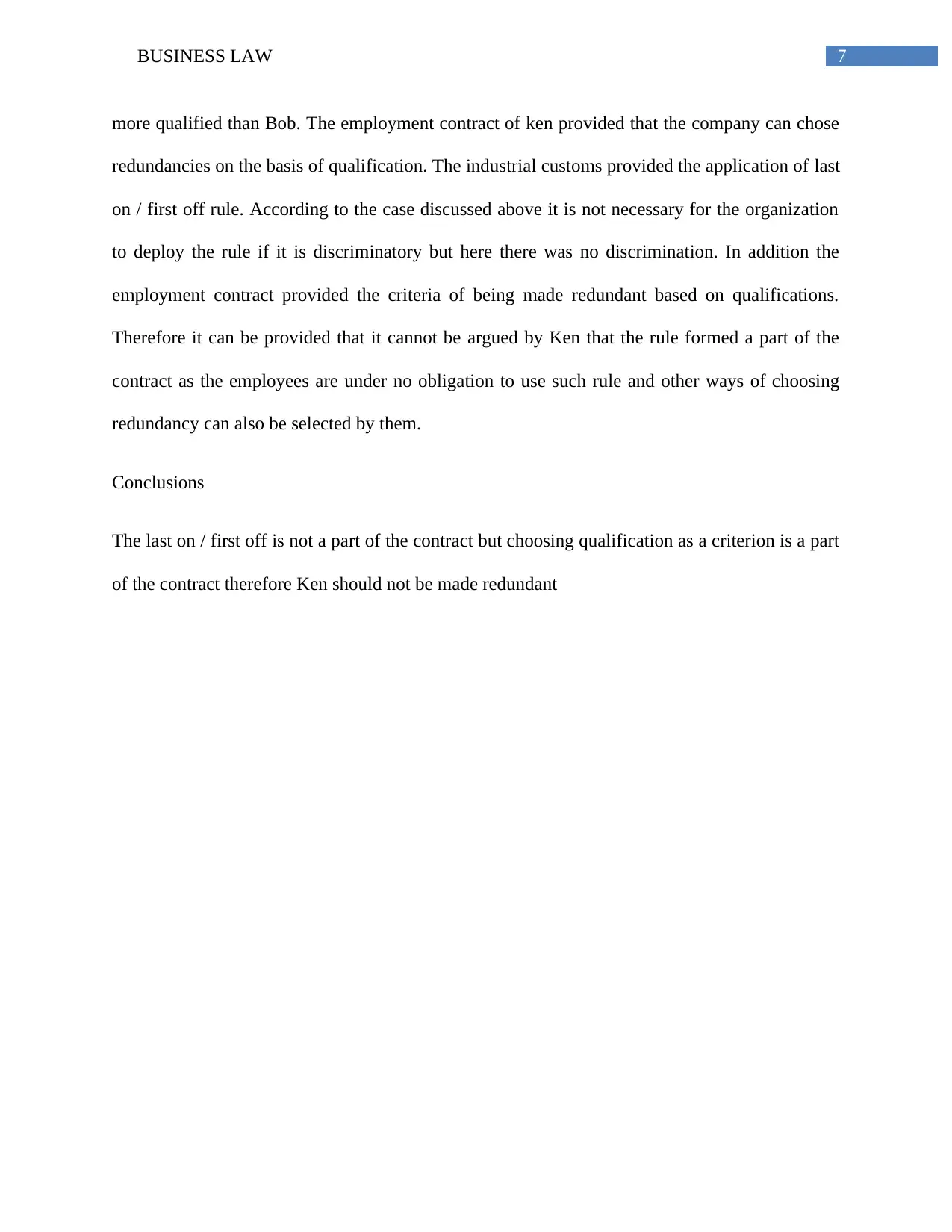
7BUSINESS LAW
more qualified than Bob. The employment contract of ken provided that the company can chose
redundancies on the basis of qualification. The industrial customs provided the application of last
on / first off rule. According to the case discussed above it is not necessary for the organization
to deploy the rule if it is discriminatory but here there was no discrimination. In addition the
employment contract provided the criteria of being made redundant based on qualifications.
Therefore it can be provided that it cannot be argued by Ken that the rule formed a part of the
contract as the employees are under no obligation to use such rule and other ways of choosing
redundancy can also be selected by them.
Conclusions
The last on / first off is not a part of the contract but choosing qualification as a criterion is a part
of the contract therefore Ken should not be made redundant
more qualified than Bob. The employment contract of ken provided that the company can chose
redundancies on the basis of qualification. The industrial customs provided the application of last
on / first off rule. According to the case discussed above it is not necessary for the organization
to deploy the rule if it is discriminatory but here there was no discrimination. In addition the
employment contract provided the criteria of being made redundant based on qualifications.
Therefore it can be provided that it cannot be argued by Ken that the rule formed a part of the
contract as the employees are under no obligation to use such rule and other ways of choosing
redundancy can also be selected by them.
Conclusions
The last on / first off is not a part of the contract but choosing qualification as a criterion is a part
of the contract therefore Ken should not be made redundant

8BUSINESS LAW
References
ACE Insurance Limited v Trifunovski [2013] FCAFC 3
Australian Iron & Steel Pty Ltd v Banovic (1989) 168 CLR 165
Bagenstos, S. R. (2013). Employment Law and Social Equality. Mich. L. Rev., 112, 225.
Hollis v Vabu Pty Ltd (t/as Crisis Couriers) (2001) 207 CLR 21
Kaplan, J., & Botes, J. (2015). It's leave, Jim, but not as we know it: employment law. Without
Prejudice, 15(6), 37-39.
Kavanagh, M., & McRae, E. (2017). Employment law: Protecting vulnerable workers
amendment to fair work act. Governance Directions, 69(4), 241.
Perritt Jr, H. H. (2016). Employment law update. Wolters Kluwer Law & Business.
Russell, R. (2017). Concentrate Questions and Answers Employment Law: Law Q&a Revision
and Study Guide. Oxford University Press.
Sappideen, C., O'Grady, P., & Riley, J. (2016). Macken's Law of Employment.
Stevens v Brodribb Sawmilling Co Pty Ltd [1986] HCA 1
Twomey, David. Labor and Employment Law: Text & Cases. Cengage Learning, 2012.
Walsh, D. J. (2015). Employment law for human resource practice. Nelson Education.
References
ACE Insurance Limited v Trifunovski [2013] FCAFC 3
Australian Iron & Steel Pty Ltd v Banovic (1989) 168 CLR 165
Bagenstos, S. R. (2013). Employment Law and Social Equality. Mich. L. Rev., 112, 225.
Hollis v Vabu Pty Ltd (t/as Crisis Couriers) (2001) 207 CLR 21
Kaplan, J., & Botes, J. (2015). It's leave, Jim, but not as we know it: employment law. Without
Prejudice, 15(6), 37-39.
Kavanagh, M., & McRae, E. (2017). Employment law: Protecting vulnerable workers
amendment to fair work act. Governance Directions, 69(4), 241.
Perritt Jr, H. H. (2016). Employment law update. Wolters Kluwer Law & Business.
Russell, R. (2017). Concentrate Questions and Answers Employment Law: Law Q&a Revision
and Study Guide. Oxford University Press.
Sappideen, C., O'Grady, P., & Riley, J. (2016). Macken's Law of Employment.
Stevens v Brodribb Sawmilling Co Pty Ltd [1986] HCA 1
Twomey, David. Labor and Employment Law: Text & Cases. Cengage Learning, 2012.
Walsh, D. J. (2015). Employment law for human resource practice. Nelson Education.
⊘ This is a preview!⊘
Do you want full access?
Subscribe today to unlock all pages.

Trusted by 1+ million students worldwide
1 out of 9
Related Documents
Your All-in-One AI-Powered Toolkit for Academic Success.
+13062052269
info@desklib.com
Available 24*7 on WhatsApp / Email
![[object Object]](/_next/static/media/star-bottom.7253800d.svg)
Unlock your academic potential
Copyright © 2020–2025 A2Z Services. All Rights Reserved. Developed and managed by ZUCOL.





